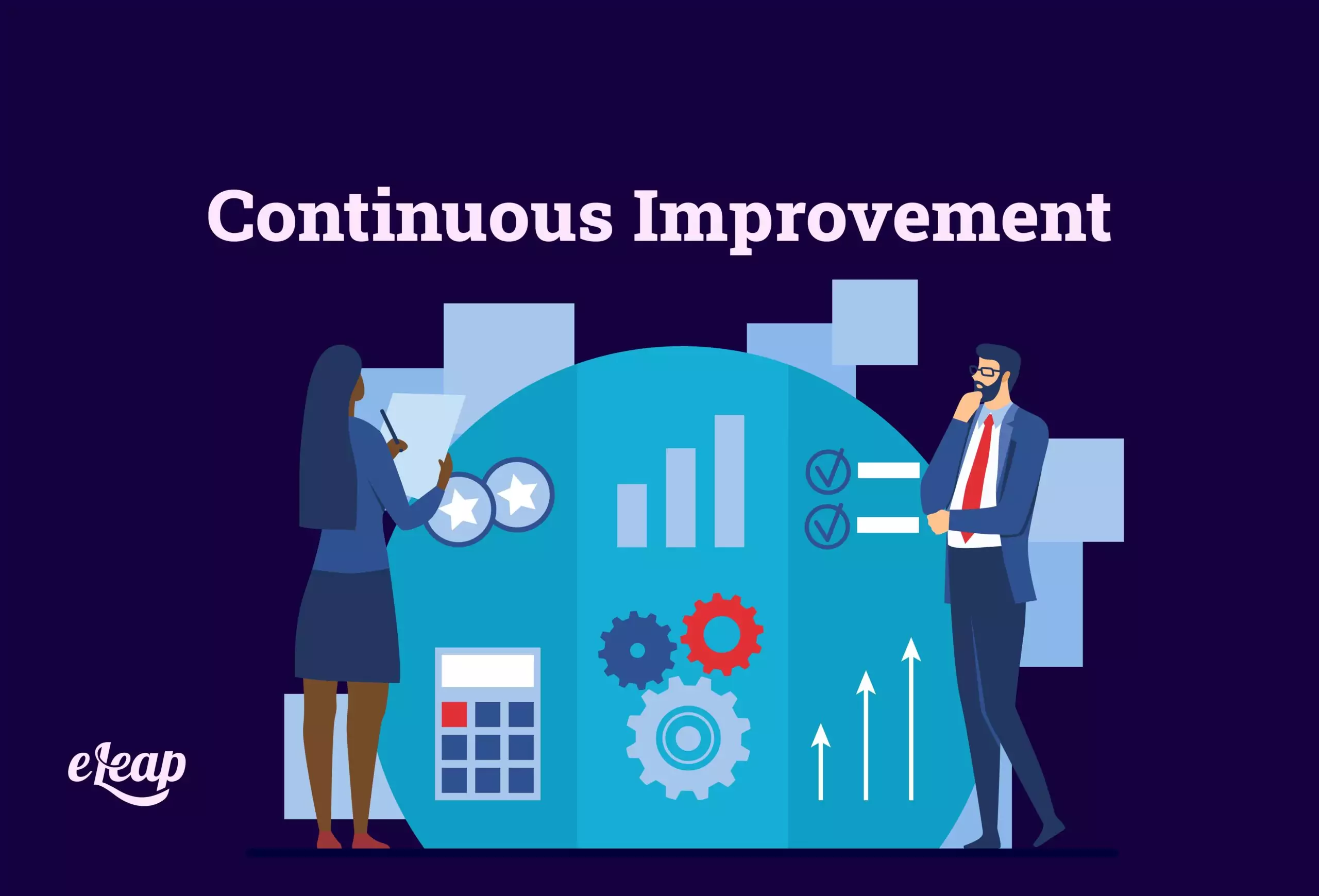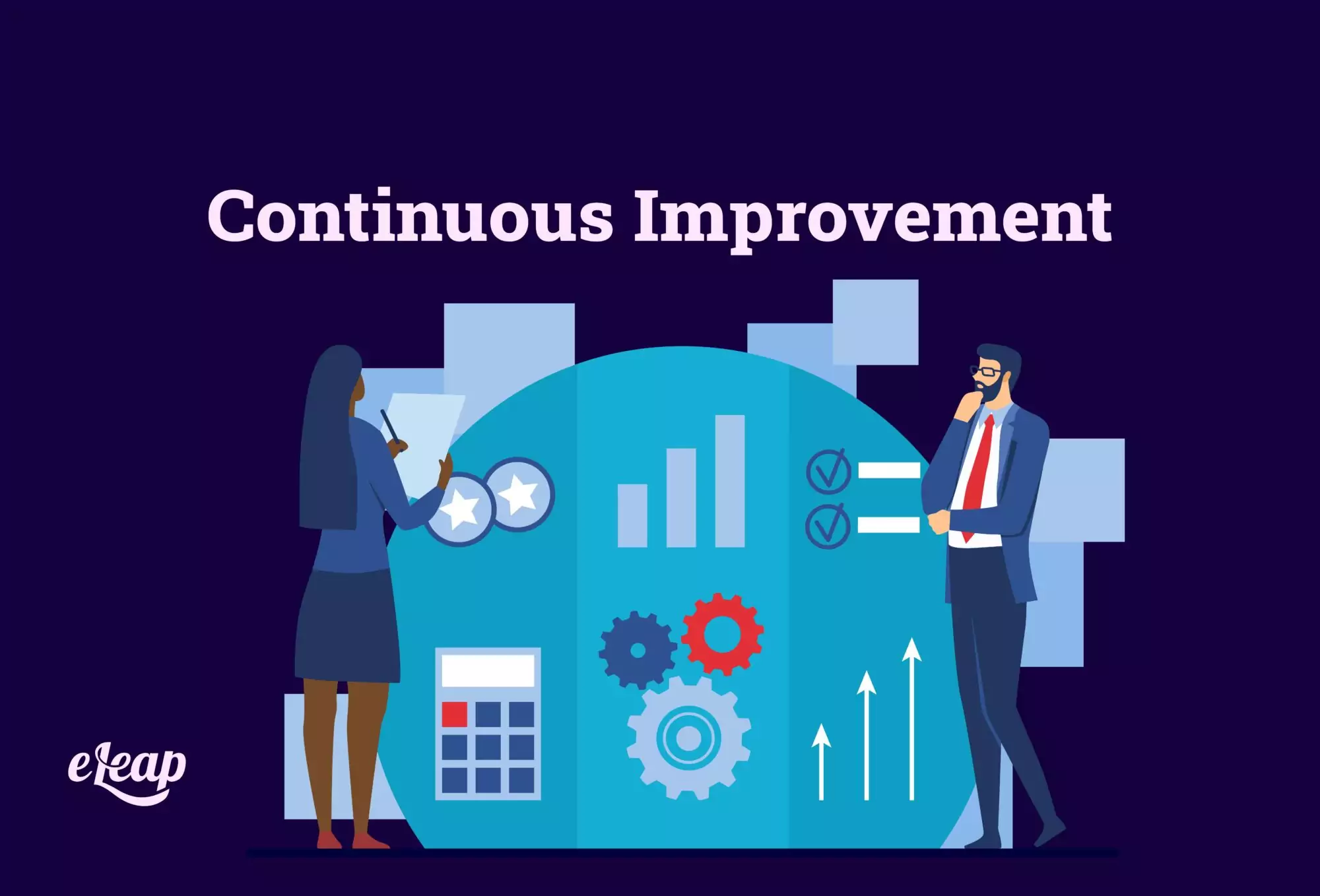Continuous Improvement
Improvement is an ongoing effort

There are so many policies, processes, and procedures that a company needs to be aware of in order to stay profitable and efficient. When you start a business, your end goal might be to get everything in working order and then simply let all the revenue flow in. There’s no question that a process of continuous improvement should be one of your core strategic objectives.

In reality, however, there are always places that these policies, processes, and procedures can be improved. Even if they worked well for years and years, company dynamics change, legislation creates new requirements, employees have different needs, and the market and competition evolve constantly, so you and your business need to, too.
Continuous improvement is the idea that people on your team are always looking for ways where things can be improved so that the business can run better. However, in order to improve any area of a business, that area needs to be flushed out and written down so that it can actually be looked at and improved in a specific way.
So first, make sure your business policies, processes, and procedures are written down. Then you can continuously look at how to improve them. Remember that policies tell why something is done, processes tell how something is done, and procedures give the step-by-step tasks.
Benefits of Process Improvement
There are many areas where continuous improvement will ripple benefits into your company.
Improved Systems
Just because a business is doing well doesn’t mean that there aren’t areas where it can be improved. Anything that humans or machines do has room for error, and when something has been used for a long time there are plenty of users who will have had ideas about something new or innovative that they would like to be done with said system.
Don’t be afraid to change something even if it isn’t broken… good can always become great. Think about it as “fine-tuning” as opposed to fixing.
Innovation
People who are bored with the same old tedious work day in and day out are not going to perform at peak level. Asking employees to find areas for improvement and then showing them how they will benefit from said improvements is a great way to keep things fresh and keep employees on their proverbial toes.
Successful businesses don’t settle for doing things in an “okay” way. The companies that stand out over and above the crowd are the ones who bring something to the table that is unlike anything else out there. Encourage your employees to come in with creative ideas that might not have ever been addressed, and truly put effort into trying some of them out.
Customer Satisfaction
Loyal customers find confidence and comfort in getting the same thing every time; however, they also enjoy having new options and a product or service that is competitive with what others are offering. Remember to continue doing primary market research on your target market and taking into consideration if the needs and pain points of your customers are changing. Do you need to change along with them? The answer is always yes.
Creating a Culture of Positivity
Do you want to have a workforce that struggles to come into work every day, can’t wait to clock out, and grumbles and gripes the whole time they are there? Or do you want to have employees who are loyal to their job and their team, who bring their best efforts and ideas to the table, who encourage each other and spread the word that your company is one of the best to work for and purchase from? Obviously, it’s the latter.
When your company is always trying to improve itself, it motivates your employees to better themselves as well. They know that the company values itself and them, and they will follow suit with an attitude that breeds improvement.
Higher Profits and Reduced Loss
It seems obvious that continuous improvement would bring in more revenue, but some businesses fail to see that putting in the extra time and effort has exponential benefits. If you are improving a process that involves tangible materials, then reducing waste will mean less money down the drain. If something gets done more quickly, your company can produce more of your product in less time. If employee engagement and communication are improved, then people will stay around longer, which means less time and money needs to be spent on recruiting and training new employees.
Using continuous improvement means that you will have a solid, standardized framework that can keep your business functioning efficiently and productively no matter the crisis that occurs. All documents will be available for anyone who needs to come into the business at any time, and there is a starting place to work from for troubleshooting problems that inevitably arise.
Signs Indicating You Need to Start *Now*
Continuous improvement is something that every business should be doing at every stage of their company’s life. However, if any of the below is happening in your workplace, then this needs to move to the forefront of management activities. If you continue to ignore these signs, your business is sure to come tumbling down.
- Processes that are not scalable or duplicatable
- If something is done well in one area, but not in another, that doesn’t make sense! On the flip side, if one person is doing it a certain way but that can’t be duplicated by others, it isn’t efficient.
- Duplication of processes
- (This is different from the duplication which is wanted above.) Here, if tasks are being completed twice or three times unnecessarily, then this is a huge source of waste. If something gets done right, it only needs to be done once.
- Constant errors
- If you see mistakes or errors happening often, then it’s a red flag that this is an area for improvement. When mistakes happen, someone has to go back and fix them, which is essentially a monetary loss.
- Loss of control
- If you can’t control something, it is bound to get out of hand eventually. You need to know that the way something is required to get done will be the way it happens, no matter who is performing the task.
- Dissatisfaction
- This can come from either the employee workforce, the customer base, or the management team. If people are unhappy with the way something works or the quality of a product or service, then there is generally room for improvement.
- Lack of information
- Data and research are crucial to a deep understanding of the way that businesses work, the best way to retain employees and customers, and the most efficient ways to create products and deliver services. If you aren’t collecting and/or using data to your benefit, you are missing out on the potential places for improvement and increased revenue.
Employee Buy-In and Encouraging a Positive Atmosphere
There’s no beating around the bush: if your employees are not going to be on board with what you are wanting to improve, there is going to be a power struggle. To get any type of improvement done, someone has got to do it! And people often resist change.
This is where communication is key. Put it in the hands of the employees themselves. Tell them that continuous improvement helps them as well (if company revenue increases, they will see raises and more employee benefits!), and then stay true to your word. If they know you have their best interests at heart then they will be more likely to help you get to where you want to go.
Ask your team where they see a need for improvement. What would make their work lives easier and their jobs more enjoyable? Do they need more training or a higher-quality workspace? Are teams on projects too large so people stand around doing nothing, or too small and people struggle to get work done on time?
Empower your team with the ability to bring about change. Take their ideas and actually put them into action so they can see that when they speak up, it makes a difference. Have an open-door policy that encourages conversation.
Then keep them accountable. If the team wants to see change, they will need to be a part of the manpower that brings it about. Remind them that change often comes with hurdles and roadblocks, but that you can work together as a team to get to where you all want to go.
Remember, too, that a little appreciation goes a long way. Although at the end of the day, everyone is there for a paycheck, every human also responds to other types of positive reinforcement. Get to know your employees and what makes them feel valued besides money. Is it words of affirmation? Extended break time? Surprise catered luncheons or new comfortable furniture in the break room? Whatever it is that shows you value and appreciate the hard work that they are putting in toward continuously improving the workplace… if you keep up your end of the bargain, they will continue to bring better ideas.
Final Thoughts
Remember that a house with a crumbling foundation is almost impossible to repair, no matter how often you patch up the cracked walls. Stop fixing the walls of your business and fix the foundation first.